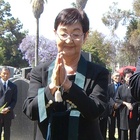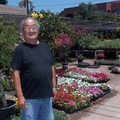During World War II, many Japanese Americans were incarcerated as "enemy aliens," but at the same time, many Japanese Americans went to the battlefield as U.S. soldiers. Some young Japanese Americans left their parents in internment camps and volunteered to serve in the military. As if to clear their frustrations, they achieved many distinguished feats on the battlefield. However, in the case of Harry Mizuno Yoshinori (83), from Bingham, Utah, who worked in Japan as a U.S. Army civilian and served in the Korean War as a member of the Military Intelligence Service (MIS), the degree of frustration may have been even greater. Mizuno was raised as a Buddhist from a young age. Even after learning that his mother and sister had been killed in an air raid by the U.S. military, he still fought as a soldier for the country, taking to heart the words of his parents that "we owe America a debt of gratitude."
From around the end of 1944, the US military intensified air raids on the Japanese mainland. The Great Tokyo Air Raid on March 10, 1945, killed approximately 100,000 people. Shimizu City in Shizuoka Prefecture was bombed on July 7 of the same year. It was targeted because it had a munitions factory.
Mizuno and her family had come to Japan in 1938. Her father, who was from Numazu, went to the United States after the Russo-Japanese War and initially worked in agriculture. He later worked as a railroad construction worker and a copper mine miner, but perhaps due to the hardships he endured, he died when Mizuno was in the fourth grade of elementary school. Her mother, who was from Shimizu City and had seven children at the time, was told by her brother-in-law, "Come back, I'll take care of you," so she returned to Japan. She also wanted to bury her husband's remains in their hometown.
A few years later, they received a letter from the consulate advising them to return to the U.S. because Japan-U.S. relations were deteriorating. Mizuno and her two sisters returned to the U.S.
His mother, older sister, younger sister and younger brother remained in Japan, but they finally completed the procedures to return to the US, and the Asama Maru departed from Yokohama. However, the ship turned back midway. In response to Japan's occupation of southern French Indochina, the US government announced sanctions including freezing Japanese assets in the country and banning oil exports to Japan, and they feared that the Asama Maru might be requisitioned as part of Japanese assets. Thus, his mother and others were unable to leave Japan.
Then, the war between Japan and the United States broke out. Mizuno lived with his uncle in Utah and attended junior high school there. Japanese people in Utah were not subject to eviction, but the police told him, "Don't go anywhere more than 10 miles from your house." The war ended the year Mizuno graduated from high school.
The following year, Mizuno returned to Japan as a military officer caring for U.S. Army officers. There, he learned that his mother and sister had died in a U.S. air raid. They had died in the Shimizu air raid.
"My cousin lives in Tachibana in Okitsu and heard that Shimizu had been attacked. He went to check it out on his bike and found his dentures lying on the ground at the entrance. He thought, 'He's been attacked,' but then he found that all that was left was bones."
Mizuno was unbearable. The shock exploded into anger. Although many people had evacuated at the time, his mother and others had received notices saying "not to do so," so they stayed in Shimizu City. And so they were subjected to air raids. So he rebelled against the Japanese police who actually issued such notices. "When I saw the police, they were fighting." He also took issue with the American commander who led the air raids. "The commander didn't say anything." Now, 65 years after the war, Mizuno says, "Was he planning to shoot his enemy? Looking back, I wonder why he did such a stupid thing," but this episode clearly shows just how big a shock it was.
Five years later, in 1951, he returned to the United States and enrolled at Los Angeles City College, but within a year he was drafted, this time to serve in the Korean War.
"Ever since we were little, our parents would often tell us that you were born in America, you were allowed to go to American schools, and you received an American education. So we owe America a debt of gratitude. We have an obligation to serve America. Don't forget to give back."
You joined the U.S. military five years after learning that your mother and sister had been killed in a U.S. air raid. How did you feel at that time?
By the way, according to Mizuno, many Japanese soldiers who served in World War II, including the members of the 442nd Regimental Combat Team, who achieved many distinguished service members, were Buddhists. This was especially true of Japanese soldiers from Hawaii. He said he could tell they were Buddhists because they were carrying charms and prayer beads. Mizuno's brother-in-law and uncle also served in the 442nd Regimental Combat Team. Mizuno was raised as a Nichiren Buddhist from a young age, and even now, every Sunday, he and his daughter go to a temple in Los Angeles from Cypress, Orange County, where they live, to listen to sermons.
*This article was originally published in the weekly Buddhist Times (July 22, 2010) with additional revisions and additions.
© 2010 Yukikazu Nagashima












